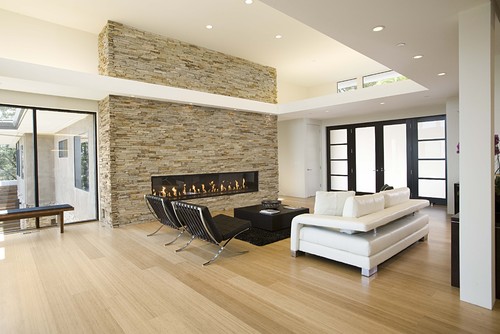Cheap Flooring Ideas: 4 Attractive and Inexpensive Alternatives to Hardwood

New floors do a lot for a home. They can brighten up the darkest of interiors and are all but guaranteed to add value to your property. Most homeowners consider installing new floors a huge renovation project that comes with a correspondingly huge price tag. But laying down new flooring doesn’t have to force you to break into your 401(k).
You can make a big impact on the design and worth of your home for a relatively small amount of cash. How? You need to think beyond standard (and standardly expensive). Instead, opt for a flooring material that is just as attractive—just without all those extra zeros.
Here are the four most popular inexpensive flooring ideas, including their advantages and disadvantages. Go ahead, pick your material!
1. Cork

Price: $2 to $4 a square foot
Pros: “Cork floors provide warmth and comfort underfoot,” says Mina Fies, founder and CEO of Washington, DC–based Synergy Design & Construction. “They’re also sustainable, since cork is a rapidly renewable resource that doesn’t harm trees when harvested.”
Cork also emits few volatile organic compounds, which means it won’t harm indoor air quality. Also, the softness of cork is good for your legs, back, and ears.
“Not only is it considered resilient flooring, but it also has acoustical properties that can help mitigate unwanted sound,” says Claire E. Tamburro, interior designer at Tamburro Interiors in Arlington, VA.
Designwise, Tamburro explains, cork floors can be charred to make unique patterns, and colored and finished in several ways. For example, you can create wide plank-style cork boards in gray or brown tones to resemble hardwood flooring.
Cons: Since cork is porous, it will need to be regularly sealed to maintain its clean finish, Tamburro says. The amount of foot traffic will determine the frequency of sealing.
“Cork is a bit fragile and will show wear patterns in heavy traffic areas,” she says.
Also, some cork floors are hard to clean and prone to fading. They can also stain easily, Fies says. Alas, cork is not so ideal for red-wine drinkers or families with young kids.
2. Bamboo

Photo by Mark English Architects, AIA
Bamboo floors are prized as an eco-friendly choice because bamboo grows at a much faster rate than wood.
Price: Approximately $4 a square foot
Pros: Like hardwood flooring, bamboo is long-lasting and sturdy.
“It’s a sustainable, eco-friendly hardwood alternative that’s easy to clean,” according to Matt Michael with Lowe’s in the St. Louis area.
Cons: While bamboo flooring is more water-resistant than hardwood flooring, you should still avoid placing it in high-humidity areas since it can warp. Also, the bamboo is not one of the hardest wood flooring options, so it can be more susceptible to scratches than, say, maple hardwood.
3. Concrete
Concrete moves indoors! You’ve seen how durable it is for your driveway, so why not take it for a spin in your kitchen, living room, or any space that gets a ton of foot traffic?
Price: $2 to $6 a square foot
Pros: One of the biggest advantages of concrete floors is—you guessed it—durability. It’s tough and low-maintenance.
And concrete floors make a strong aesthetic statement.
They “provide a modern, clean, urban feel to a room,” Fies says.
Cons: Concrete lacks the warmth of, say, honey-colored hardwood floors. It’s a very hard surface, which might be tough for families living with kids or elderly folks. It can be porous and susceptible to moisture if it’s not sealed properly.
Also, due to weight restrictions, Fies says installation is usually limited to the ground level. So if you want to avoid defects, you’ll need to hire someone who can provide expert workmanship.
Vinyl flooring may have gotten a bad rap during the ’70s, but like many design trends from that era, it’s now making a comeback.
Price: 50 cents to $5 a square foot
Pros: Vinyl may be one of the cheapest flooring options out there, but that doesn’t mean it lacks style. Luxury vinyl tile is particularly impressive.
“LVT is long-lasting, hard-wearing, easy to clean, and gives a modern look to any space,” Fies says. “It can mimic wood effectively, even including texture and plank style.”
Vinyl is highly resistant to water, which makes it a great alternative to wood in a basement level, where moisture may be a concern.
“As a longtime interior designer, I was recently sourcing material for a client and accidentally picked up EVP thinking it was hardwood,” says Kristin Davidson, an interior designer at Kristin Davidson Interiors in Palm Beach, FL.
Cons: Vinyl floors may require waxing every couple of years to maintain their luster.





